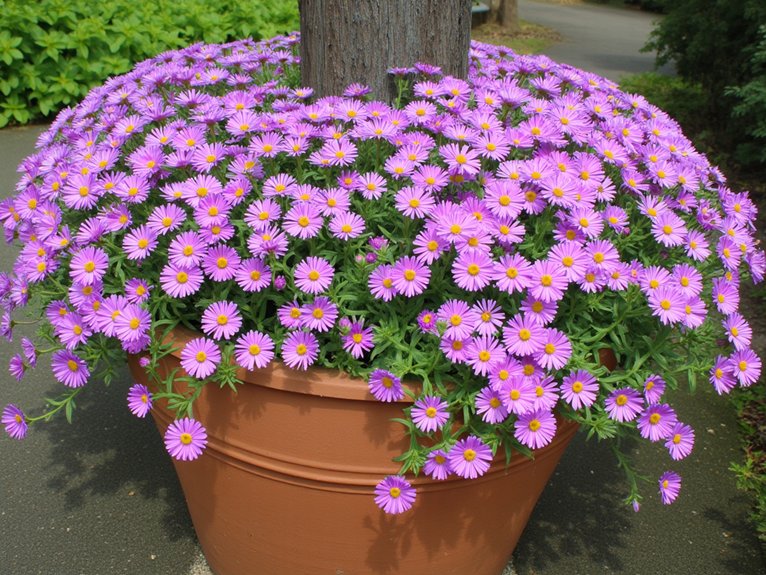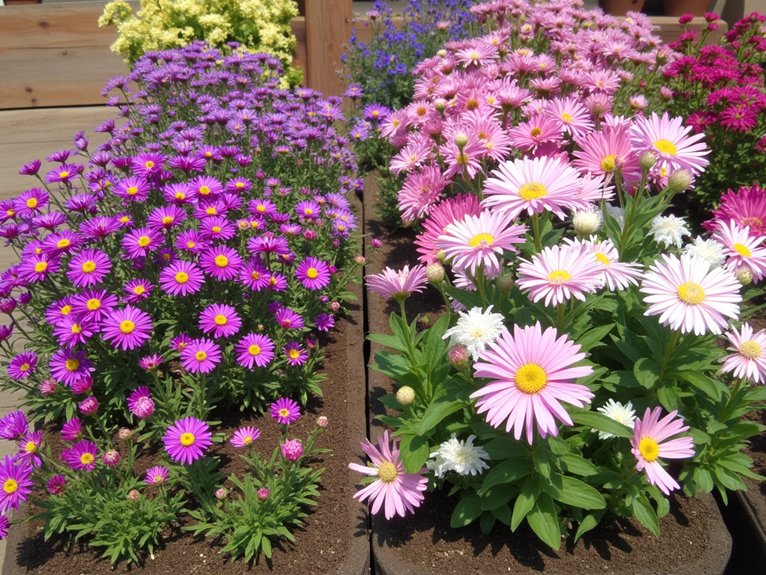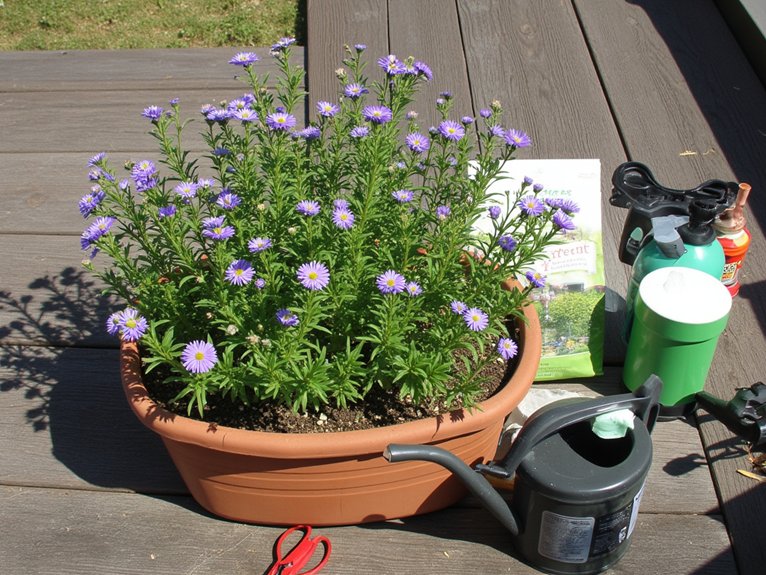You’ll discover that asters make excellent container garden specimens, with their abundant blooms and adaptable nature. According to horticulturist Dr. Sarah Chen, “These versatile perennials can transform even the smallest patio into a pollinator paradise.” Whether you’re working with compact New England varieties or spreading New York asters, proper container selection and soil preparation will determine your success. Let’s explore the essential techniques that guarantee these late-season stars thrive in your outdoor space.
Contents
Why Asters Excel in Container Gardens

While many flowering plants struggle in containers, asters thrive when given proper care and conditions. You’ll love their adaptability and extended blooming period, which brings vibrant colors to your garden when other plants start fading.
The aster benefits are impressive – these hardy perennials offer heights from 1 to 6 feet and come in stunning shades of pink, purple, white, and blue. They’re perfect for container aesthetics because they bloom reliably from late summer through fall, creating eye-catching displays on patios and balconies. Plus, they’re tough enough to handle zones 3 through 9, making them ideal for diverse growing conditions.
Essential Container and Soil Requirements
Once you’ve decided to grow asters in containers, selecting the right pot and soil becomes your essential first step. Choose a container width that matches your aster’s mature spread, with a height about half its full size. For proper drainage, confirm your pot has holes covering 1/5 of its bottom.
For soil composition, you’ll want to skip garden soil and opt for a quality potting mix that combines mineral and organic materials. Don’t line your containers with rocks or bottles – this can actually harm drainage. Instead, focus on a well-draining medium that’ll keep your aster’s roots healthy and prevent rot.
Selecting the Perfect Aster Varieties

When choosing aster varieties for your containers, you’ll need to contemplate both the plant’s mature size and your pot dimensions. New England varieties reach heights of 3-6 feet, while New York asters stay compact at 1-3 feet tall.
For smaller containers, try New York cultivars like ‘Fellowship’ with pink blooms or ‘Royal Ruby’ featuring deep red flowers. If you’ve got larger pots, New England varieties offer stunning options. ‘Purple Dome’ displays rich purple flowers, while ‘Alma Potschke’ brings vibrant salmon-pink colors to your fall garden.
“The key is matching aster heights to container scale,” says master gardener Sarah Chen.
Companion Plants and Design Strategies
As you plan your container garden’s design, pairing asters with complementary plants creates visual interest throughout the growing season. Consider color combinations by mixing early-blooming creeping phlox and dianthus with your asters for continuous color.
Create dynamic height layering by positioning taller asters like ‘Alma Potschke’ in the center or back, then surround them with mid-height catmint or salvia. Edge your containers with trailing plants like alyssum or vinca for a polished look.
“The key is selecting companions that share similar sunlight and drainage needs,” says Master Gardener Jane Smith. “This guarantees all plants thrive together.”
Proper Care and Maintenance Tips

Since successful container gardening depends on consistent care, maintaining your potted asters requires attention to several key factors throughout the growing season. You’ll need to monitor soil moisture daily, fertilize every 4-6 weeks with balanced nutrients, and employ proper pruning techniques to encourage blooming.
For pest management, inspect your plants weekly for common issues like aphids or spider mites. Remove spent blooms regularly and trim back any yellowing foliage. Water thoroughly in the morning, allowing excess moisture to drain completely. During hot spells, you may need to water twice daily, especially if using terra cotta containers.
Year-Round Protection and Seasonal Success
Although container-grown asters are hardy perennials, they’ll need strategic protection throughout the year to maintain their importance and blooming potential. Follow these essential steps for year-round success:
- Move containers to a sheltered location when temperatures drop below 40°F
- Apply winter insulation by wrapping pots in burlap or bubble wrap
- Implement seasonal rotation of containers based on sun exposure
- Reduce watering by 50% during dormant winter months
- Add 2-3 inches of mulch around the plant base
“The key is protecting the root system,” says horticulturist Dr. Jane Smith. “Container plants are more vulnerable to temperature fluctuations than those in the ground.”
